| Author |
Message |
Harry Marinakis

|
 Posted: Sat 25 Aug, 2012 5:05 pm Post subject: Which side was the sword worn? Posted: Sat 25 Aug, 2012 5:05 pm Post subject: Which side was the sword worn? |
 |
|
I'm looking for factual answers with historical evidence, not opinions.
Thank you.
Firesteel Designs
Hand-crafted good lovingly infused with hemoglobin
|
|
  |
 |
Robin Smith

|
 Posted: Sat 25 Aug, 2012 5:50 pm Post subject: Posted: Sat 25 Aug, 2012 5:50 pm Post subject: |
 |
|
If I am understanding your question, Art and Effigies make it clear that swords tended to be worn suspended by a belt on the left hip. Which is where you would expect it for a right handed person.
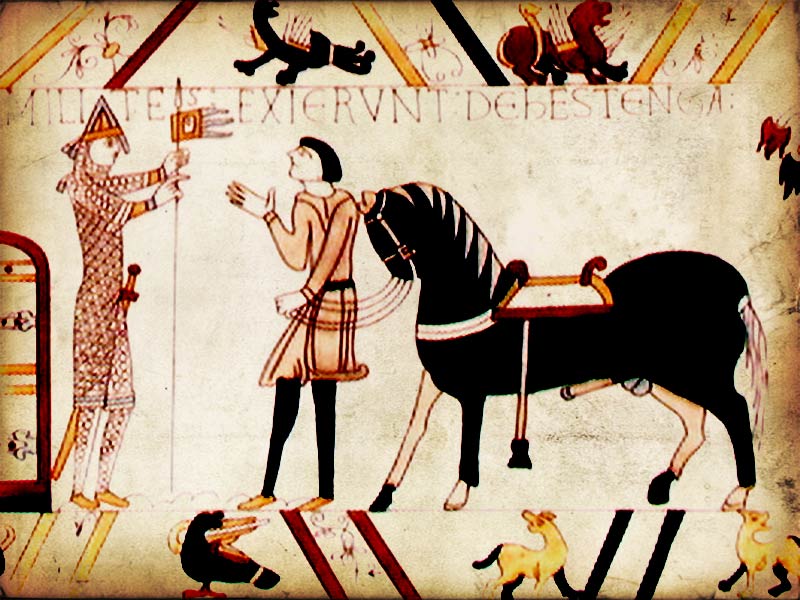
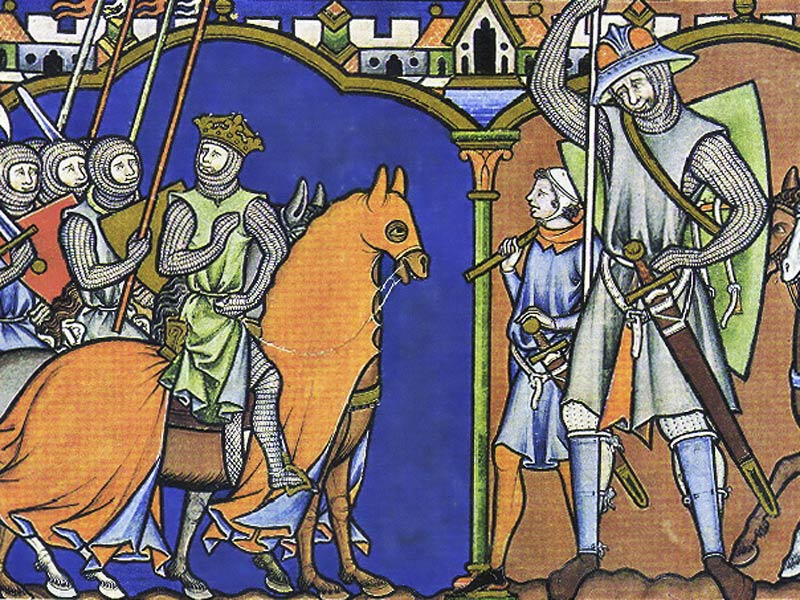
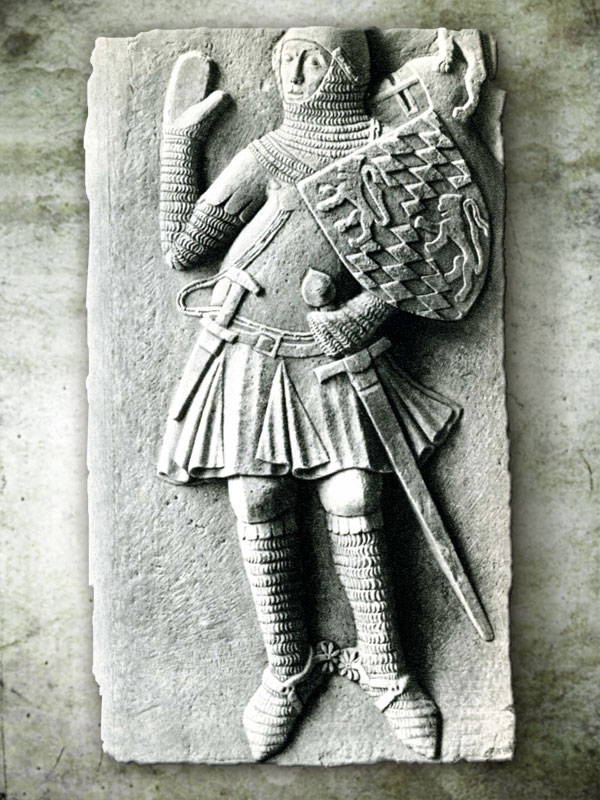
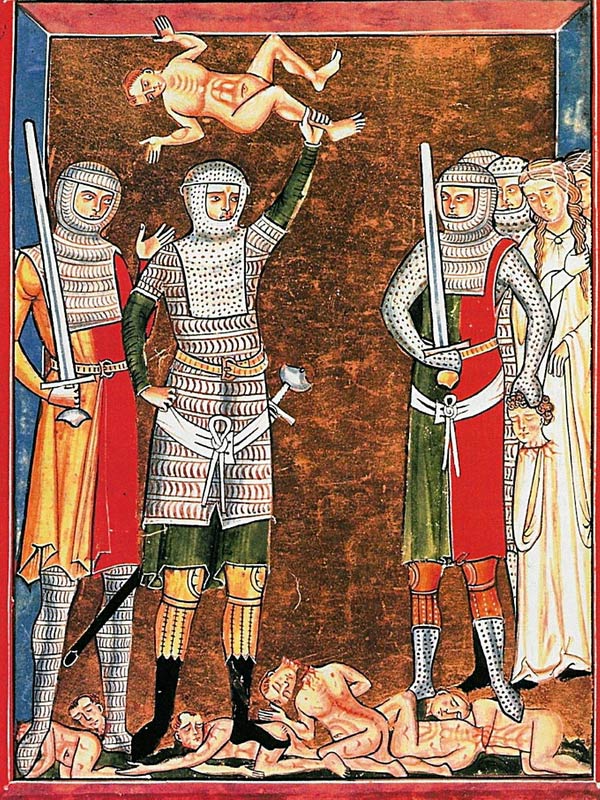
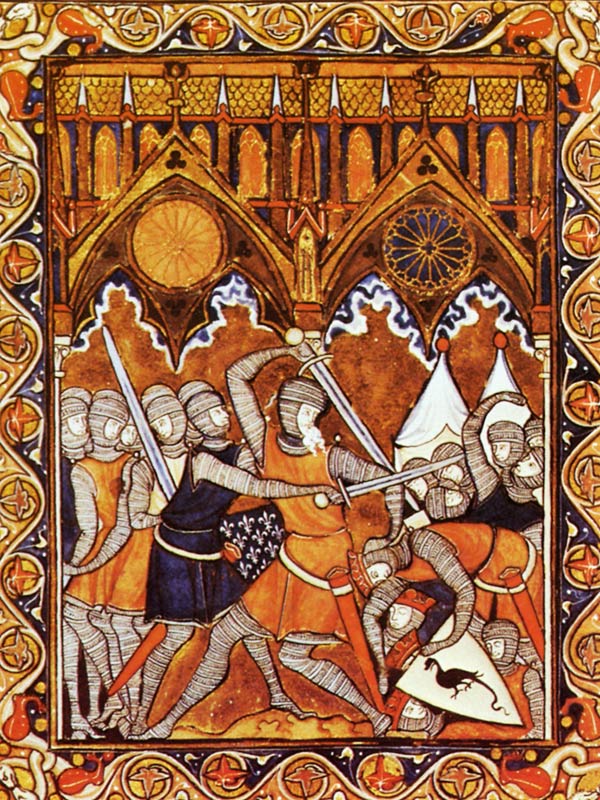
A furore Normannorum libera nos, Domine
|
|
   |
 |
Harry Marinakis

|
 Posted: Sat 25 Aug, 2012 6:59 pm Post subject: Posted: Sat 25 Aug, 2012 6:59 pm Post subject: |
 |
|
Thanks very much for your reply.
I have seen art and effigies with the swords on both sides. Some swords are carried on the right, but mostly on the left hip. I wish that I had saved the references to show them here.
In your 2nd photo, the two on the right are obviously right-handed and carry their swords on on their left hip.
In your 4th photo, the man in the center is using his left hand to hold up the body - which could mean that he is left-handed. And his sword is on the left hip.
So...
Is the sword generally carried on this hip opposite from the dominant hand?
(Right handed, draw from the left hip)
(Left handed, draw from the right hip)
Or is the sword generally carried on the left hip regardless of the knight's handedness?
(Right handed, draw from the left hip)
(Left handed, draw from the left hip)
How does a mounted knight draw his sword from beneath his shield (on the left) and swing it across his horse's neck to the right (right hand)? Wouldn't it be easier to draw if it were already carried on the right?
It seems that the shield on the left also covers and protects the sword (on the left) from being pilfered.
I'd like to see more art and effigies with left-handers, and art and effigies with swords carried on the right hip.
Thank you.
Firesteel Designs
Hand-crafted good lovingly infused with hemoglobin
|
|
  |
 |
|
Raman A
Location: United States Joined: 25 Aug 2011
Posts: 148
|
 Posted: Sat 25 Aug, 2012 7:09 pm Post subject: Posted: Sat 25 Aug, 2012 7:09 pm Post subject: |
 |
|
|
Could you clarify the time period and region you're interested in? Swords have historically been worn on both sides of the body for a right-handed man, its cultural.
|
|
  |
 |
Nathan Robinson
myArmoury Admin


|
|
    |
 |
Dan Howard

|
 Posted: Sat 25 Aug, 2012 8:31 pm Post subject: Posted: Sat 25 Aug, 2012 8:31 pm Post subject: |
 |
|
The time period wasn't specified in the OP. Didn't the Romans wear the gladius on the right?
Last edited by Dan Howard on Sat 25 Aug, 2012 8:33 pm; edited 1 time in total
|
|
  |
 |
Chuck Russell

|
 Posted: Sat 25 Aug, 2012 8:32 pm Post subject: Posted: Sat 25 Aug, 2012 8:32 pm Post subject: |
 |
|
|
romans wore their swords on their right hips.
|
|
    |
 |
Robin Smith

|
 Posted: Sat 25 Aug, 2012 8:58 pm Post subject: Posted: Sat 25 Aug, 2012 8:58 pm Post subject: |
 |
|
I was under the impression that in the medieval world left-handedness was considered a negative trait, perhaps even as far as being associated with the devil and the occult. And because of this left-handedness was hidden and shunned and those who were forced to learn to be right handed.
A furore Normannorum libera nos, Domine
|
|
   |
 |
Harry Marinakis

|
 Posted: Sat 25 Aug, 2012 10:59 pm Post subject: Posted: Sat 25 Aug, 2012 10:59 pm Post subject: |
 |
|
Thank you again for your replies.
I am interested in all time periods, but especially 10th-16th centuries.
Firesteel Designs
Hand-crafted good lovingly infused with hemoglobin
|
|
  |
 |
|
Ralph Grinly
|
 Posted: Sat 25 Aug, 2012 11:04 pm Post subject: Posted: Sat 25 Aug, 2012 11:04 pm Post subject: |
 |
|
|
I think one of the reasons governing what side the sword is carried on is the average length of the blade. A longish blade is generally carried on the opposite hip to the dominant hand..as you have the abilty to draw easier that way" I've heard that the romans carried their shorter gladius's on the right hip and drew it by gripping the hilt, pushing the scabbard down and drawing blade with a downwards motion..easy to do with scabbard carried on a shortish baldric, and above waist height ?
|
|
  |
 |
Eric S

|
 Posted: Sun 26 Aug, 2012 12:27 am Post subject: Posted: Sun 26 Aug, 2012 12:27 am Post subject: |
 |
|
|
In Japan the sword was always on the left, left handed samurai were not allowed.
|
|
   |
 |
|
Matthew Amt
|
 Posted: Sun 26 Aug, 2012 6:39 am Post subject: Posted: Sun 26 Aug, 2012 6:39 am Post subject: |
 |
|
Romans *typically* carried their swords on the right, except for centurions who wore theirs on the left. But there are exceptions in both directions, and that's only good up into the 2nd century AD or so.
Greeks wore their swords on the left, whatever the length. Gauls and Britons seem to have worn theirs on the *right*, including very long examples. They were probably not meant to be "quick-drawn"!
I was also under the impression that warriors and soldiers generally fought right-handed. I think there are a couple exceptions from the ancient periods, but I don't have any citations offhand. (Ooo, pun not intended, but I'm leaving it!)
Matthew
|
|
   |
 |
|
G K Vaughn
Location: Australia Joined: 22 Jun 2011
Posts: 19
|
 Posted: Sun 26 Aug, 2012 6:57 am Post subject: Posted: Sun 26 Aug, 2012 6:57 am Post subject: |
 |
|
It's reasonably easy to draw even quite a long sword (though probably not an *actual* longsword) from the right side. Here's a link to a demonstration video.
"The rifle is no more than the grip of the bayonet."
--Giuseppe Garibaldi
|
|
  |
 |
Mikko Kuusirati

|
 Posted: Sun 26 Aug, 2012 7:17 am Post subject: Posted: Sun 26 Aug, 2012 7:17 am Post subject: |
 |
|
| Matthew Amt wrote: | | I was also under the impression that warriors and soldiers generally fought right-handed. I think there are a couple exceptions from the ancient periods, but I don't have any citations offhand. (Ooo, pun not intended, but I'm leaving it!) |
Well, yes - military formations like the phalanx cannot easily accommodate the differently handed. 
"And sin, young man, is when you treat people like things. Including yourself. That's what sin is."
— Terry Pratchett, Carpe Jugulum
|
|
  |
 |
|
Mart Shearer
|
 Posted: Sun 26 Aug, 2012 8:31 am Post subject: Posted: Sun 26 Aug, 2012 8:31 am Post subject: |
 |
|
| Robin Smith wrote: | | I was under the impression that in the medieval world left-handedness was considered a negative trait, perhaps even as far as being associated with the devil and the occult. And because of this left-handedness was hidden and shunned and those who were forced to learn to be right handed. |
Dexter or "right" gives us dexterous--having skill with the hands, clever, while sinister or "left" gives us that evil guy. The evolution in meaning of those two words pretty well sums it up.
ferrum ferro acuitur et homo exacuit faciem amici sui
|
|
  |
 |
Quinn W.

Location: Bellingham, WA Joined: 02 May 2009
Posts: 197
|
 Posted: Sun 26 Aug, 2012 9:08 am Post subject: Posted: Sun 26 Aug, 2012 9:08 am Post subject: |
 |
|
I am left handed and wear a scabbard with a suspension on my left (simply because I bought it pre-made and didn't really have a choice). It is still pretty easy to draw, as the linked video above mentioned, but the motion does not feel as intuitive in my opinion as a cross-draw. Even though it is not my dominant hand, sometimes I will draw it with my right hand and pass it to my left just because it is more comfortable. Obviously, though, that's not an ideal way to get your sword ready so I suspect the cross-draw was the way to go throughout periods where longer swords were used.
Sorry, I know the OP said evidence, not opinions, but it looks like his question was answered pretty well in the first few posts so I'll throw in some subjective observation anyway.
For an existing discussion of left-handed fighters in history, take a look at this older thread.
http://www.myArmoury.com/talk/viewtopic.php?t...light=left
"Some say that the age of chivalry is past, that the spirit of romance is dead. The age of chivalry is never past, so long as there is a wrong left unredressed on earth"
|
|
   |
 |
|
Scott Woodruff
|
 Posted: Sun 26 Aug, 2012 1:18 pm Post subject: Posted: Sun 26 Aug, 2012 1:18 pm Post subject: |
 |
|
|
This thread has been most helpful to me. I can no longer hold a sword with my right hand due to shoulder, elbow and wrist injury, but all my scabbards are rigged for left side wear. I actually never thought of drawing with my left hand! Duh! Though it may look akward to observers, I now find left hand draw from a left side scabbard to be easier and more natural than right hand draw from left side scabbard ever was. Thank you G K for the link.
|
|
  |
 |
Harry Marinakis

|
 Posted: Mon 27 Aug, 2012 5:10 pm Post subject: Posted: Mon 27 Aug, 2012 5:10 pm Post subject: |
 |
|
Excellent discussion, thank you
Firesteel Designs
Hand-crafted good lovingly infused with hemoglobin
|
|
  |
 |
Mark T

|
 Posted: Tue 28 Aug, 2012 2:49 am Post subject: Posted: Tue 28 Aug, 2012 2:49 am Post subject: |
 |
|
| G K Vaughn wrote: | | It's reasonably easy to draw even quite a long sword (though probably not an *actual* longsword) from the right side. Here's a link to a demonstration video. |
And this is still done today in military and self-defence contexts (for better or worse, it's commonly called the 'cavalry draw'): tactical benefits are that it's often quicker, has less of a 'tell' or indexing, and means that your draw arm can't be trapped in close quarter fighting. Given that you draw with the back of the hand facing the body and the little finger pointing down, this means that single-edged weapons are carried with the blade facing forward (and slightly down) rather than the traditional backwards for a standard draw. In turn, this means that the weapon is drawn with the blade presented during a rising cut, if need be; alternately, it can be drawn up, and then snap-cut down quickly.
To see Bill Bagwell demonstrate this with a full-length Bowie, you can order Modern Knives # 5: The American Bowie Knife from Pete Kautz: http://alliancemartialarts.com/issue5.htm
Chief Librarian/Curator, Isaac Leibowitz Librarmoury
Schallern sind sehr sexy!
|
|
  |
 |
Mark T

|
 Posted: Wed 19 Mar, 2014 2:38 pm Post subject: Posted: Wed 19 Mar, 2014 2:38 pm Post subject: |
 |
|
| Harry Marinakis wrote: | | I have seen art and effigies with the swords on both sides. Some swords are carried on the right, but mostly on the left hip. I wish that I had saved the references to show them here. |
Hi Harry,
I suspect that images of left-handed scabbard suspensions are more common in period art than many of us realise.
Here are just a few that I know of.
First up is one image from Jean de Wavrin's Chronique d'Angleterre, Royal MS 14 E IV f. 34 r, which contains not one but three depictions of left-handed sword suspensions. Note that while two are single-handed swords (or perhaps bastard swords), one is a messer or falchion.
Images courtesy The British Library: http://www.bl.uk/manuscripts/Viewer.aspx?ref=..._iv_fs001r
 Attachment: 153.06 KB Attachment: 153.06 KB
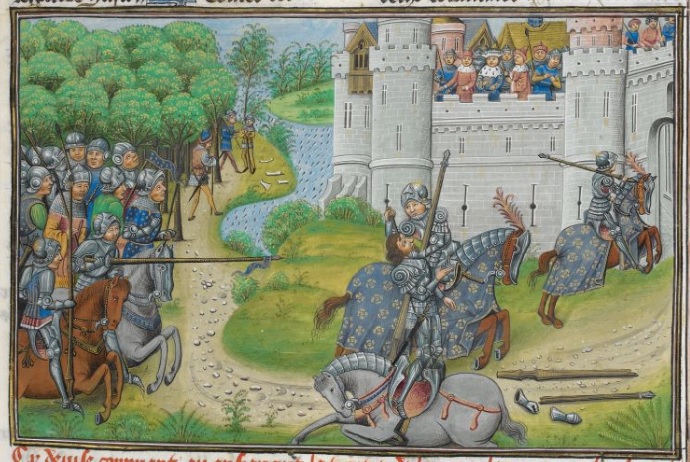
 Attachment: 94.22 KB Attachment: 94.22 KB
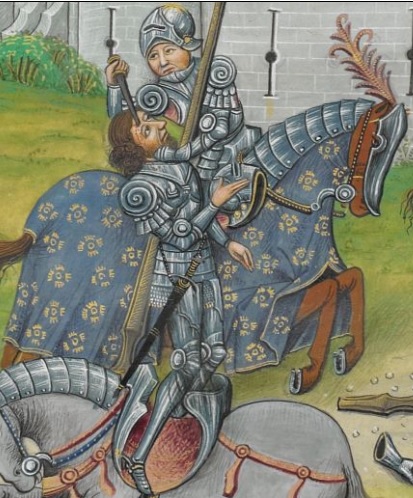
 Attachment: 50.98 KB Attachment: 50.98 KB
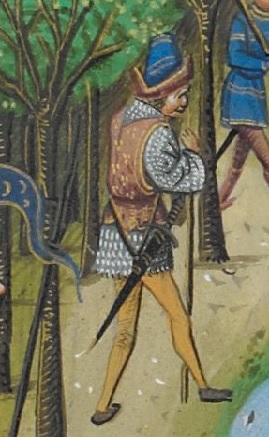
 Attachment: 55.23 KB Attachment: 55.23 KB

Chief Librarian/Curator, Isaac Leibowitz Librarmoury
Schallern sind sehr sexy!
|
|
  |
 |
|
|

